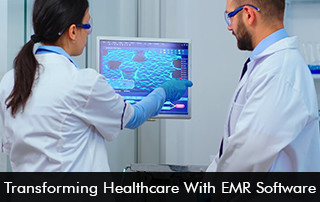EMR software is a digital tool for managing patient records. It replaces paper charts and securely stores medical data on computers or cloud servers. EMR software allows healthcare professionals to access patient history, test results, and treatment plans at the click of a button.
The Evolution of EMR Software
Before EMR software, doctors used paper charts. Paper records were easy to lose and time-consuming to manage. Digital systems changed everything. Earlier softwares were basic. It only stored patient information. Modern systems are much more advanced. They integrate with other tools and provide analytical insights.
Key Benefits of EMR Software
Improved Efficiency
EMR software reduces paperwork and repetitive tasks. Doctors can delegate the day-to-day administrative tasks and focus on patients. Even with doctor consultations, EMR takes the lead in ease and efficiency. From annotating images to preloaded symptom templates, EHR software saves time and lowers stress levels.
Better Patient Care
EMR enables quick recall of patient data, as well as an accurate briefing of their healthcare history. Access to accurate, up-to-date records helps doctors make informed decisions. This leads to better diagnoses and treatment plans.
Enhanced Collaboration
Patients often have more than one medical concern. They require consultation from more than one practitioner, and often from different facilities. EHR software enables doctors, nurses, and specialists to share information quickly, improving teamwork and reducing errors.
EMR Software Data Security
Paper records can be lost or stolen. It has happened in the past, leading to the need for EMR. The digital software uses encryption to protect patient information. This ensures compliance with privacy laws like HIPAA.
Features of Modern EMR Software
Customization
Not all healthcare practices are the same. Every practice has its way of doing things. Doctors can customize EMR software to suit their needs. This includes adding templates for common procedures or creating specific workflows.
EMR Software Integration
EHR software can integrate with other tools, such as billing software, lab systems, and telemedicine platforms, to streamline operations. This facilitates seamless task resolution and takes a lot of worry and running around out of the equation.
Analytics and Reporting
Modern EMR software analyzes patient data to identify trends. This helps in preventive care and population health management.
EMR Software Mobile Access
Many EMRs offer mobile apps. Doctors can access patient records from their phones or tablets. This is especially useful for home visits or emergencies.
Challenges in Implementing EMR Software
High Initial Costs
Installing EHR software can be expensive. Though there are many affordable vendors available, costs can rack up, especially for smaller practices. Small clinics may struggle to afford it, or opt for a vendor that doesn’t meet all of their needs.
Learning Curve
Healthcare staff need training to use the software effectively. This takes time and resources. It is also expensive. Many vendors include training within their price but the time it takes to become proficient can be costly.
Data Migration
Transferring data from paper to digital systems is a complex process. It requires careful planning and execution. This is another cost variable that practices need to be mindful of when selecting a vendor.
EMR Software and Patient Engagement
Online Portals
Many EMRs include patient portals. Patients can view their records, schedule appointments, and communicate with doctors online. This takes a lot of headaches out of the patient-doctor relationship.
Personalized Care
EMR software helps doctors tailor treatments. Patients receive care that matches their unique needs.
Increased Transparency
Patients can see their medical history and understand their treatment plans. This builds trust and improves satisfaction.
The Future of EMR Software
Artificial Intelligence (AI)
AI can analyze EMR data to predict health risks. This allows doctors to intervene early and prevent complications.
Voice Recognition
Voice-enabled EMR systems let doctors dictate notes instead of typing. This saves time and improves documentation accuracy.
Blockchain Technology
Blockchain can make EHR software even more secure. It ensures that patient data is tamper-proof and traceable.
Choosing the Right EMR Software
Assess Your Needs
Identify the features you need most and choose a vendor accordingly. Many specialty-specific vendors are tailored to specialty-specific needs.
Vendor Support
Choose a vendor that offers excellent customer support. This is crucial for training and troubleshooting.
Scalability
Select a software that can grow with your practice. It should handle an increasing number of patients and staff.








